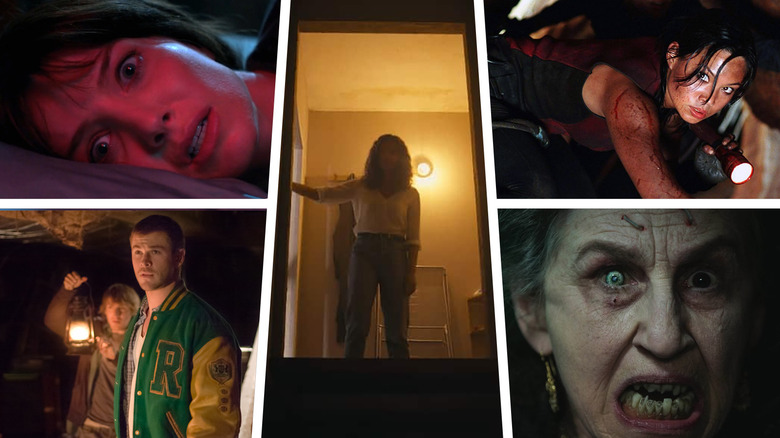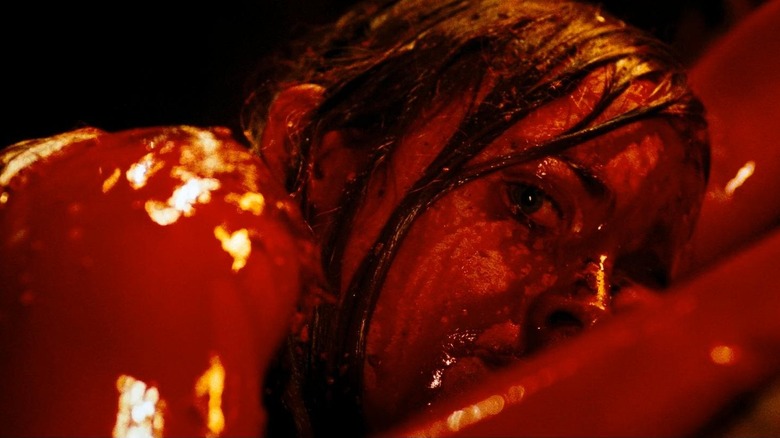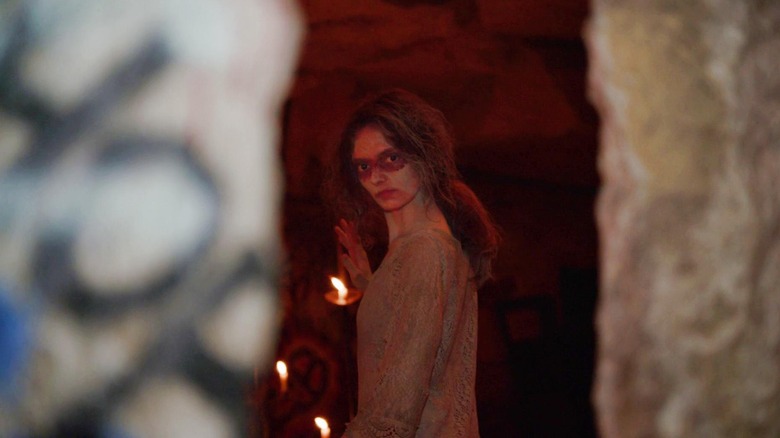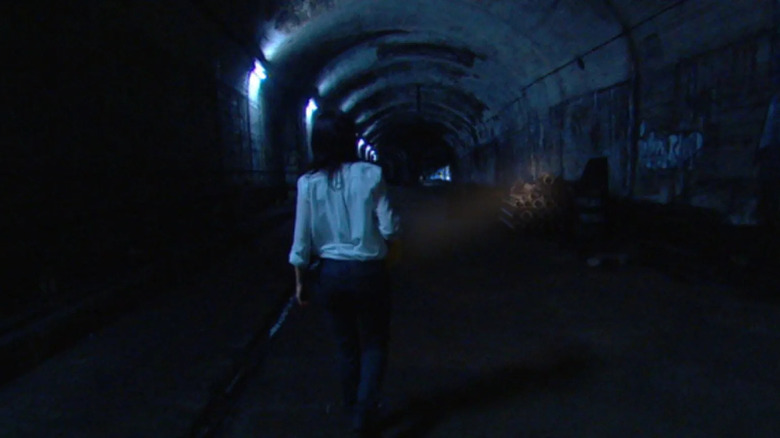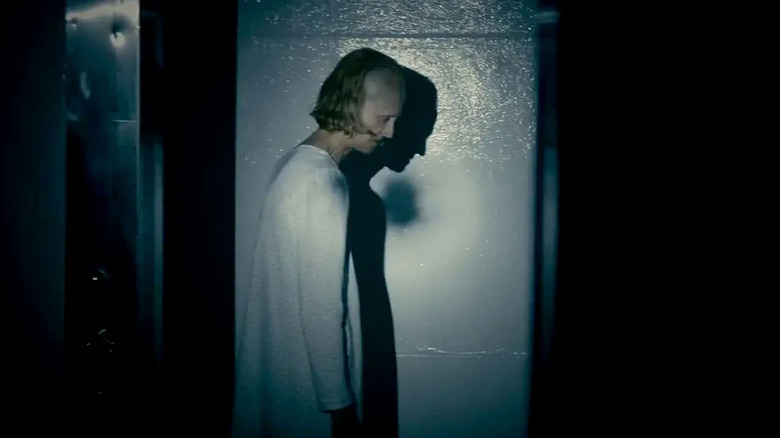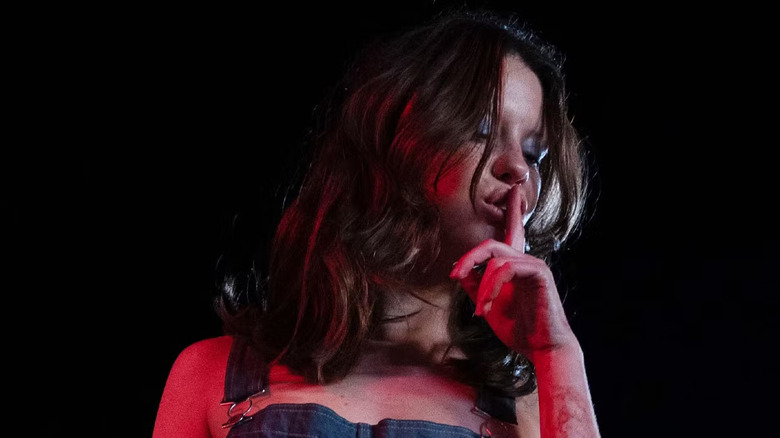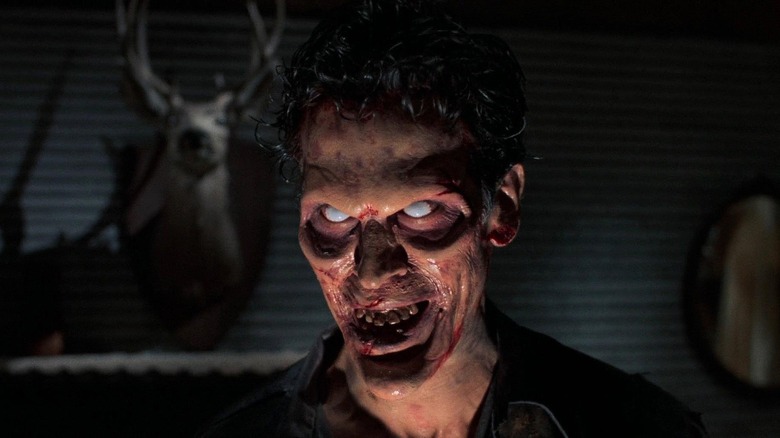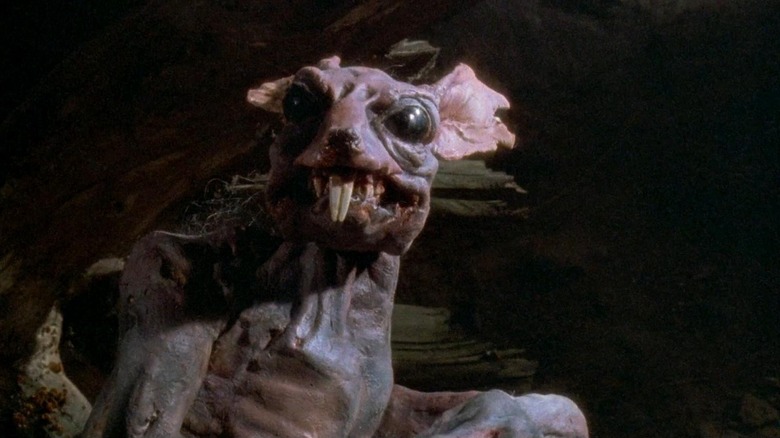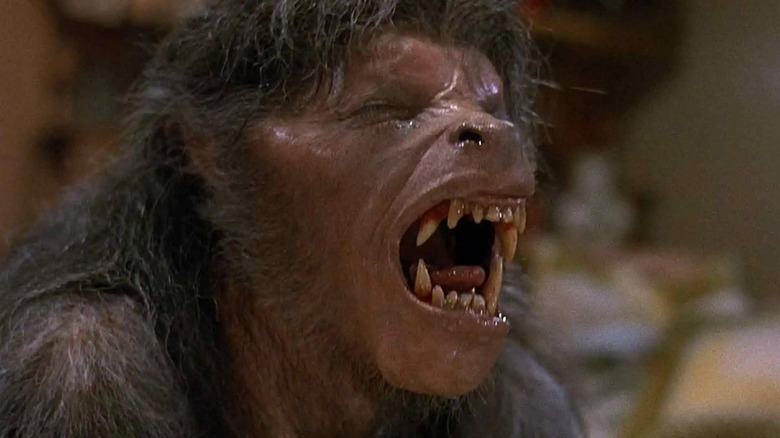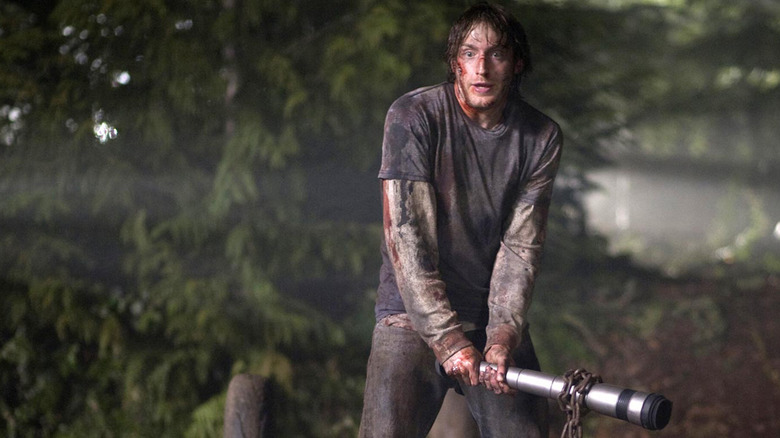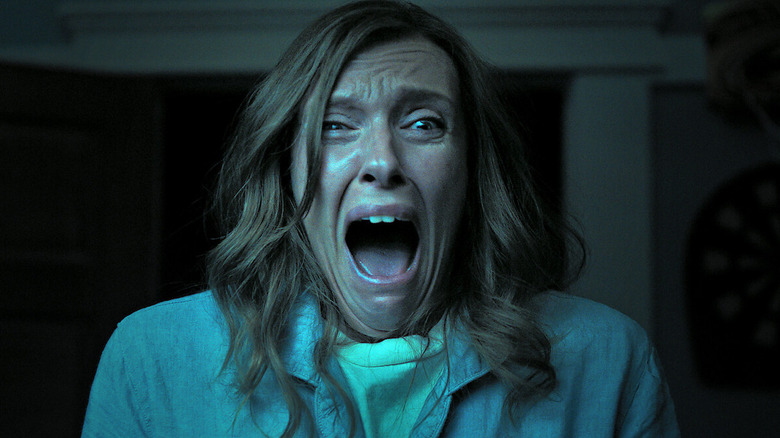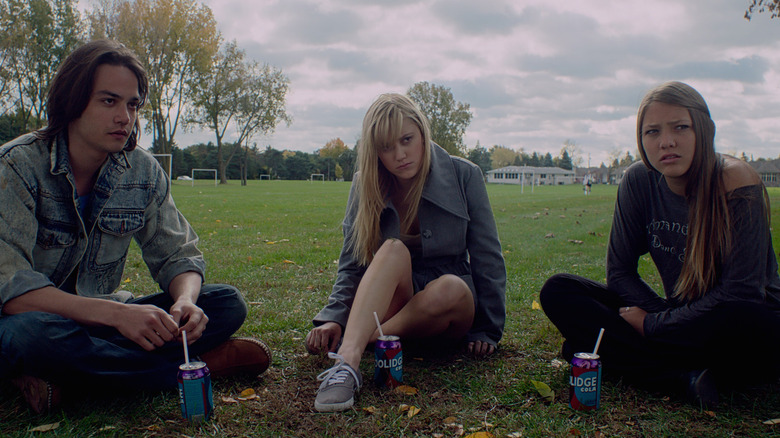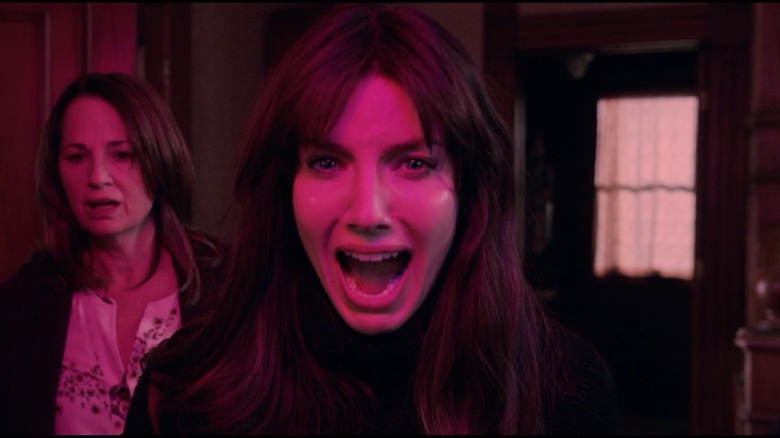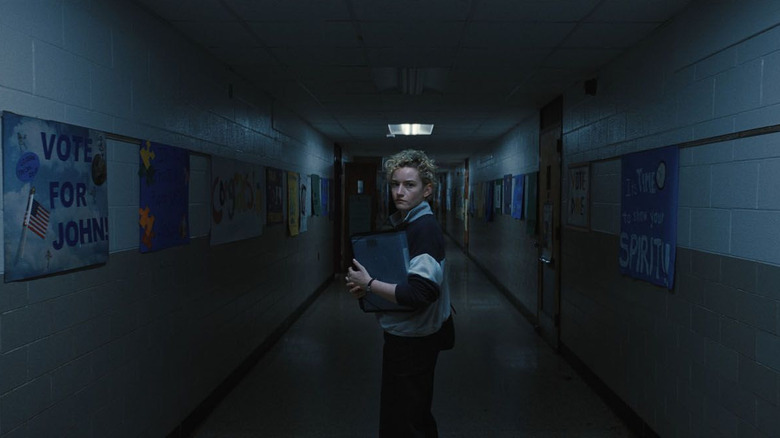15 Best Movies Like Barbarian
There are a lot of elements that contribute to "Barbarian" being one of the most genuinely shocking horror films of the decade so far. Director Zach Cregger, former member of the sketch comedy troupe The Whitest Kids U'Know, made an unexpected and indelible mark on genre cinema, seemingly out of nowhere, dropping this A+ example of midnighter genre cinema that springboarded him into making "Weapons," one of the most talked-about movies of 2025.
The ghoulish magic of "Barbarian" is how it concocts a mixture that stands entirely on its own out of a clear-as-day set of influences. It's a movie that will make you think of the greatest subterranean horror films you've ever seen, and the craziest hagsploitation movies, and those movies with that elusive, perfect blend of laughs and scares, and the distinct cinematic eye of the likes of Sam Raimi, Peter Jackson, and James Wan. And yet, "Barbarian" still feels like lightning in a bottle.
Nevertheless, we've pulled together 15 of the best movies that feel like "Barbarian," so you can try and chase more of this fusion of claustrophobic atmosphere and surprising narrative and tonal mutation that feels hard to get anywhere else.
The Descent
If we're starting in the realm of subterranean horror, look no further than "The Descent." English director Neil Marshall's nail-biter about a group of hobbyist spelunking women who get trapped in an unexplored cave system that contains dangers far past what they had signed up for lives on as a cult classic because of its suffocating atmosphere and, like "Barbarian," its wild and unpredictable story trajectory.
Indeed, while a movie about people stuck in the dark, inescapable, labyrinthian tunnels that wind under the earth is scary in its own right, there's a reason "The Descent" is on our list of the 50 scariest horror movie monsters. Once the film moves into a state of our characters being actively hunted throughout these caverns, it really comes alive, making this the kind of underground monster movie that others of its ilk refer back to as a model of how to do this stuff right.
As Above, So Below
Keeping with the underground theme, we have a slice of found-footage horror that has slowly been accumulating its own cult fandom since its release in 2014. "Quarantine" director John Erick Dowdle keeps true to the confined terror of that film by following a group of young friends searching for the philosopher's stone within the Paris catacombs.
As I'm sure you can guess, things don't go as planned, and soon the group is beset by ghosts, demons, and an entire upside-down world of terrors that seek to keep our young protagonists trapped underneath the Parisian streets forever. "As Above, So Below" may grate if you're sick of the found footage template, and there's an argument that this movie could have been seen as a modern classic if made traditionally. But for those who find comfort in those familiar trappings, it's a welcome dose of nerve-wracking, bump-in-the-night type of frights. More horror movies should be about people discovering entrances to Hell, if you ask me.
The Tunnel
Speaking of people going into the cavernous tunnels underneath their city to find something horrifying, "The Tunnel" explores what great terrors are lurking underneath the scariest country of all: Australia, where a group of journalists go way too deep down under as they investigate why their Sydney's government suddenly stopped a plan to begin efficiently recycling underground water reservoirs within underground train tunnels, where there's also word of local unhoused people going missing.
If we compare "The Tunnel" to the model example of found footage, "The Blair Witch Project," which achieves scares through a "less is more" approach, "The Tunnel" does kind of the opposite and decides more is more. But that's not necessarily a bad thing, and director Carlo Ledesma mines some gnarly tension out of whatever freaky entity it is that's lurking and stalking our crew of investigators deep down in the bowels of the city. I'm always going to be partial to people running around in tunnels, so it's maybe no shock that I will recommend the movie called "The Tunnel."
The Taking of Deborah Logan
I promise this is the last found-footage film on this list, but this is another one that's pretty effective, and it starts getting into another main element of "Barbarian," and that's hagsploitation, or old ladies being scary — with this one scary enough to end up on our list of 25 scariest found footage horror movies. "The Taking of Deborah Logan" adds that type of urgent immediacy you get from the genre to the cataloging of Alzheimer's patient Deborah Logan (Jill Larson), who may actually be an accomplice in a devilish supernatural pact.
Most people who have seen "The Taking of Deborah Logan" remember it for one specific unsettling shot of the main subject's face, let's say, unnaturally contorting in a particularly disturbing act of devouring, but the rest of the film accomplishes an effectively unnerving atmosphere built around a perfectly eerie performance from Larson. The obligatory warning about genre/style trappings certainly applies here, but "Deborah Logan" eventually captures some of that elderly creature fright you get from Cregger's flick.
X
Here's nnother pull from the murderous old ladies category, but this time with a slasher-Americana pastiche bent. Ti West's slick and stunning "X" proved popular enough to help spawn an entire trilogy of bloody genre flicks, all led by Mia Goth. However, "X" is the most successful in its bare-bones, slightly winking yet largely back-to-basics approach to modern horror.
Whereas the contemporary landscape for the genre has seen great, overwrought success by indulging in heavier, artier fare, "X" finds success in its straightforward nature. Goth leads a group of porn filmmakers out to a rural Texas farm to secretly film a new movie, right under the noses of their elderly hosts, including the furtively homicidal Pearl, also played by Goth under piles of makeup, and who she would reprise in the following prequel named for the character. Eyes are gouged, alligators are fed, and heads are smashed in the proceedings, and West still manages to smuggle in something of a poignant emotional core within all his backwoods slasher stylizations.
Drag Me To Hell
Which better filmmaker to add among the scary seniors company than Sam Raimi, whose "Drag Me to Hell" can reasonably assert itself as perhaps the defining picture of the subgenre for the 21st century. Or, maybe more specifically, the perfect one to come out in the wake of the 2008 financial crisis, wherein Alison Lohman plays a banker named Christine Brown, who finds herself under the violent curse of an old woman whom she denies a loan.
Raimi squeezes this premise for every ounce of mean-spirited juice that it's worth, putting Lohman through so much over-the-top, comically gross agony that it's hard not to laugh along with a man clearly having a ball pulling the strings, making something filled with so much rogue-like mischief. Giving Raimi free rein behind the camera to make something that's as much "The Three Stooges" as it is bugged-out supernatural frightfest is like letting the most excitable kid you know loose at his favorite amusement park — moderation is an empty word for him, and that includes "Drag Me to Hell's" chillingly horrifying ending. But speaking of Sam Raimi having no restraint...
Evil Dead II
It seems only right for this list to have back-to-back Raimi entries, because his splatstick style of horror comedy seems directly tied to Cregger's own ambitions for "Barbarian." (Fittingly, "Drag Me to Hell" and "Evil Dead II" are both films Cregger directly listed as inspirations for his film.) "Evil Dead II" is the textbook example of both what to do with a horror sequel and what to do with a horror movie that's meant, more than anything else, to be raucous fun.
"Evil Dead II" abandons the looming, chaotic dread of the first film and instead turns toward anarchic absurdity. With his wildly flying camera, penchant for icky practical effects, and directing a star with the capacity for carrying slapstick in Bruce Campbell, "Evil Dead II" represents a movie that delights so heavily in its own madness that it becomes irresistibly infectious. Even the fact that Raimi couldn't use footage from his own franchise adds a certain, curious charm — another layer that suggests you're watching a movie so delightfully out of step with practically any other movie that it becomes a genre reference point of its own accord.
Braindead
If we're talking insane horror comedies, it feels wrong not to include Peter Jackson's splatter film triumph "Braindead," which you may know better as "Dead Alive" in North America. With Jackson taking inspiration for his zombies from Monty Python, "Braindead" pulls from the same direct well of slapstick legends as Raimi, doing his part to make explicit the innate link between horror and comedy.
The difference between Jackson and Monty Python, though, is that the former made "Braindead" one of the most infamously gory horror films of all time. It's so gory, in fact, that it wraps back around to being hilarious. Sure, the film may not be for those with particularly weak stomachs, but Jackson is having too much fun pumping the screen with so much fake blood that it works its way from being sickening to simply being part of his comedic milieu.
The movie starts with a stop-motion zombie rat and only goes up from there, featuring nonstop bravura analog gore set pieces that get bigger and bigger as the film goes, culminating in a half-hour final showdown with copious, ridiculous amounts of blood splatter, dismemberment, removed organs, ripped off faces, mutated bodies, and general mayhem — all in the name of goofball camp on top of everything. Later, he would direct "The Hobbit" trilogy. Some things in this life are full of mystery.
An American Werewolf in London
Still funny but operating under a more moderate sensibility, John Landis' "An American Werewolf in London" has rightfully earned its place within the horror-comedy pantheon, and yet it will still surprise you with how well the aspects of its humor, character detail, and amazing practical effects hold up. Following two American tourists, David (David Naughton) and Jack (Griffin Dunne), as they're attacked by a strange beast while hiking in the English countryside and face the increasingly abnormal after-effects, Landis pays tribute to well-observed histories of the genre while carving out its own lane of clever surprises.
While "An American Werewolf in London" may trace its roots to monster movie classics, it's almost inconceivable in its shrewd blend of naturalistic laughs and edgy, fatalistic horror. True to this idea is its abrupt, smash-cut ending, which is both mean-spirited and funny as hell, as if the entire movie is one 90-minute buildup to a nasty punchline. It's hard to make horror comedies work, but it's even harder to make the movie itself be both a joke and earnest genre construction. Somehow, "An American Werewolf in London" pulls it off.
Shaun of the Dead
Speaking of horror comedies set in that great British metropolis of London, it would feel irresponsible not to include one of the greatest genre intersections of the 21st century. Edgar Wright extended the cult credentials he earned from working on "Spaced" and "A Fistful of Fingers" with this zombie movie/romantic-comedy mashup that helped to define the face of independent cinema in the 2000s.
That's because, despite its facetious title, "Shaun of the Dead" is not merely a simple, easy parody. The first entry in Wright's Three Flavours Cornetto Trilogy, the film subverts clichés of the subgenre with a wry, deft touch, taking its situational circumstances as seriously as it does finding genuine comedic insight. The likes of "Scary Movie" have their place, but "Shaun of the Dead" has always represented something a little sharper: a genre send-up that's made with enough technical and authorial proficiency to stand up to the best of its own predecessors.
The Cabin in the Woods
While "Barbarian" breaks down genre axioms within the context of its earnest, idiosyncratic storytelling, "The Cabin in the Woods" bulldozes the conventions of horror storytelling altogether. Celebrated subversive genre writer/director Drew Goddard teamed up with the once-celebrated authority on all things nerd and superhero culture, Joss Whedon, to make this deconstruction of the typical teen slasher template, in which the subjects therein are actually involved in a mythic, archaic sacrificial ritual to appease the gods ruling over Earth.
The result is a true-blue horror send-up that's so in love with all the archetypal cliches of the genre that it can't help but put them under a microscope to get a laugh out of how well they've been exhausted. With a perfect cast of slaughter-ready "teens," including Chris Hemsworth and a standout Fran Kranz, who are supported by the surprise co-headlining duo of Richard Jenkins and Bradley Whitford, "The Cabin in the Woods" is the type of genre satire that's clever enough to earn its sweeping cultural appraisal.
Hereditary
Believe it or not, I actually believe this slots in with the horror-comedy aspect of this list. No, it's not a slapstick joyride like "Braindead" or even a loving homage like "The Cabin in the Woods." Ari Aster's modern cult favorite "Hereditary" is instead a movie with a much more grotesque sense of humor, one where he positions the doomed players of his story about a family subject to a generational participation in a demonic cult in a way of such fatalistic, despairing doom that you almost can't help but laugh.
With "Hereditary," Ari Aster morphs the tenets of familial melodrama into a darkly comic assembly line of tragedy and terror for his characters. "Hereditary" is still his best movie, and it's because of the dexterity with which he controls this tone of overwhelming, suffocating dread, while still making such a fatalistic hellscape a sort of waggish prank. There's no doubt that the film has contributed to a tired, overarching trend of "arthouse horror," the type of genre movies that position themselves as being a little bit more high-minded than your average studio schlock, but "Hereditary" can lay claim to being an exceptional bellwether.
It Follows
"It Follows" stands as an enduring piece of breakout 2010s indie horror, and an impressive calling card for writer/director David Robert Mitchell — so impressive that Mitchell is returning for an "It Follows" sequel, following his underrated film noir bomb "Under the Silver Lake." There's definitely an expansive world suggested within his out-of-time chiller, which has a hooky premise to boot: Maika Monroe plays teenager Jay Height, who becomes afflicted with a curse caught by having sex: she will be slowly stalked for the rest of her life by entities known and unknown until she passes the curse onto someone else.
It's the kind of weird, left-field concept that gets a potential viewer's gears turning, and the haunted, eerie suburban sprawl that Mitchell visualizes here evokes the same kind of frightening environmental familiarity that Cregger does with "Barbarian." "It Follows" never goes quite as bonkers as that movie, but, but the end, it does land within an interesting cross between ponderous arty horror, John Carpenter pastiche, and weird B-movie absurdity.
Malignant
"Malignant" reminds me of "Barbarian" in its narrative trajectory, especially how it moves from what feels like a rote and familiar premise into new territory you would have never expected, in which the filmmaker behind the thing seems like they totally lost their mind in the middle of production. That's definitely what Wan's totally berserk splatter movie evokes, and you can feel him having more fun than ever, transmuting what starts as a bog-standard bump-in-the-night haunted house movie into a crazy compound of pulp goodness.
Any movie that simultaneously reminds you of "Suspiria," "Scream," "Saw," "Basket Case," and "The Matrix" all at once should in no realistic universe actually work, but then again, Wan is no ordinary horror director. He mixes all these elements up into a beautifully nutso cocktail of grindhouse action horror, one that leaves any genre fan like me light up with how brazenly it leans into something it knows is absolutely ludicrous. But if you haven't seen "Malignant" and are still reading this far, then you've already seen far too much. Don't look up anything else, and go watch it.
Weapons
You like "Barbarian" by Zach Cregger? You want to see another Zach Cregger movie? Boy, do I have the movie for you! Though given how much "Weapons" killed it at the box office, it's likely you've already seen it. Indeed, Cregger's "Barbarian" follow-up upgraded from the cult sensation status of that film to just plain old regular sensation, the kind of surprise horror blockbuster hit that has the casual movie fans in your life asking if you've seen it yet.
Cregger approaches his sophomore feature (of the horror genre, mind you, lest we forget his comedy debut "Miss March") as a reprise of some of the themes of what made "Barbarian" work, in being another movie about the terrors behind closed doors of suburban America that once again prominently features basements and rides a contemporary wave of hagsploitation, folding all of these interests into a splintered narrative, missing-children procedural that continuously changes forms as it progresses.
If "Barbarian" was his calling card, "Weapons" is proof of the fact that Cregger isn't content to rest on his laurels — here's hoping he has plenty of unconventional genre pictures still to come.
